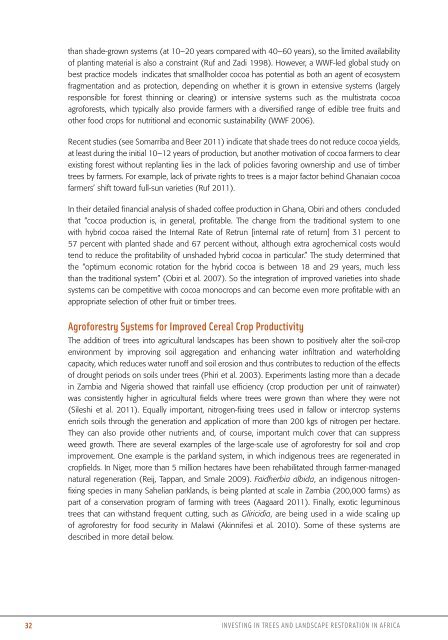INVESTING IN TREES AND LANDSCAPE ... - PROFOR
INVESTING IN TREES AND LANDSCAPE ... - PROFOR
INVESTING IN TREES AND LANDSCAPE ... - PROFOR
Create successful ePaper yourself
Turn your PDF publications into a flip-book with our unique Google optimized e-Paper software.
than shade-grown systems (at 10–20 years compared with 40–60 years), so the limited availability<br />
of planting material is also a constraint (Ruf and Zadi 1998). However, a WWF-led global study on<br />
best practice models indicates that smallholder cocoa has potential as both an agent of ecosystem<br />
fragmentation and as protection, depending on whether it is grown in extensive systems (largely<br />
responsible for forest thinning or clearing) or intensive systems such as the multistrata cocoa<br />
agroforests, which typically also provide farmers with a diversified range of edible tree fruits and<br />
other food crops for nutritional and economic sustainability (WWF 2006).<br />
Recent studies (see Somarriba and Beer 2011) indicate that shade trees do not reduce cocoa yields,<br />
at least during the initial 10–12 years of production, but another motivation of cocoa farmers to clear<br />
existing forest without replanting lies in the lack of policies favoring ownership and use of timber<br />
trees by farmers. For example, lack of private rights to trees is a major factor behind Ghanaian cocoa<br />
farmers’ shift toward full-sun varieties (Ruf 2011).<br />
In their detailed financial analysis of shaded coffee production in Ghana, Obiri and others concluded<br />
that “cocoa production is, in general, profitable. The change from the traditional system to one<br />
with hybrid cocoa raised the Internal Rate of Retrun [internal rate of return] from 31 percent to<br />
57 percent with planted shade and 67 percent without, although extra agrochemical costs would<br />
tend to reduce the profitability of unshaded hybrid cocoa in particular.” The study determined that<br />
the “optimum economic rotation for the hybrid cocoa is between 18 and 29 years, much less<br />
than the traditional system” (Obiri et al. 2007). So the integration of improved varieties into shade<br />
systems can be competitive with cocoa monocrops and can become even more profitable with an<br />
appropriate selection of other fruit or timber trees.<br />
Agroforestry Systems for Improved Cereal Crop Productivity<br />
The addition of trees into agricultural landscapes has been shown to positively alter the soil-crop<br />
environment by improving soil aggregation and enhancing water infiltration and waterholding<br />
capacity, which reduces water runoff and soil erosion and thus contributes to reduction of the effects<br />
of drought periods on soils under trees (Phiri et al. 2003). Experiments lasting more than a decade<br />
in Zambia and Nigeria showed that rainfall use efficiency (crop production per unit of rainwater)<br />
was consistently higher in agricultural fields where trees were grown than where they were not<br />
(Sileshi et al. 2011). Equally important, nitrogen-fixing trees used in fallow or intercrop systems<br />
enrich soils through the generation and application of more than 200 kgs of nitrogen per hectare.<br />
They can also provide other nutrients and, of course, important mulch cover that can suppress<br />
weed growth. There are several examples of the large-scale use of agroforestry for soil and crop<br />
improvement. One example is the parkland system, in which indigenous trees are regenerated in<br />
cropfields. In Niger, more than 5 million hectares have been rehabilitated through farmer-managed<br />
natural regeneration (Reij, Tappan, and Smale 2009). Faidherbia albida, an indigenous nitrogenfixing<br />
species in many Sahelian parklands, is being planted at scale in Zambia (200,000 farms) as<br />
part of a conservation program of farming with trees (Aagaard 2011). Finally, exotic leguminous<br />
trees that can withstand frequent cutting, such as Gliricidia, are being used in a wide scaling up<br />
of agroforestry for food security in Malawi (Akinnifesi et al. 2010). Some of these systems are<br />
described in more detail below.<br />
32 <strong><strong>IN</strong>VEST<strong>IN</strong>G</strong> <strong>IN</strong> <strong>TREES</strong> <strong>AND</strong> L<strong>AND</strong>SCAPE RESTORATION <strong>IN</strong> AFRICA

















